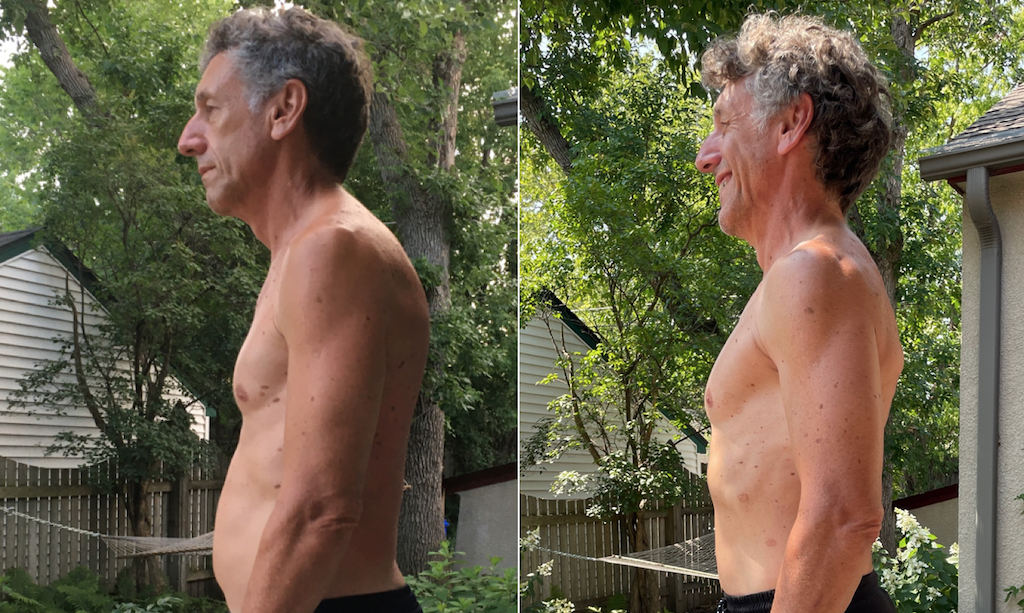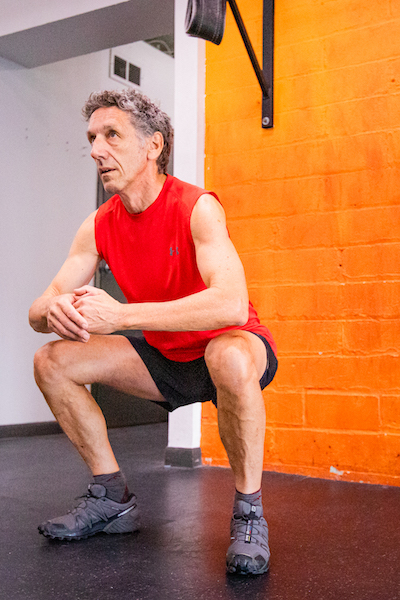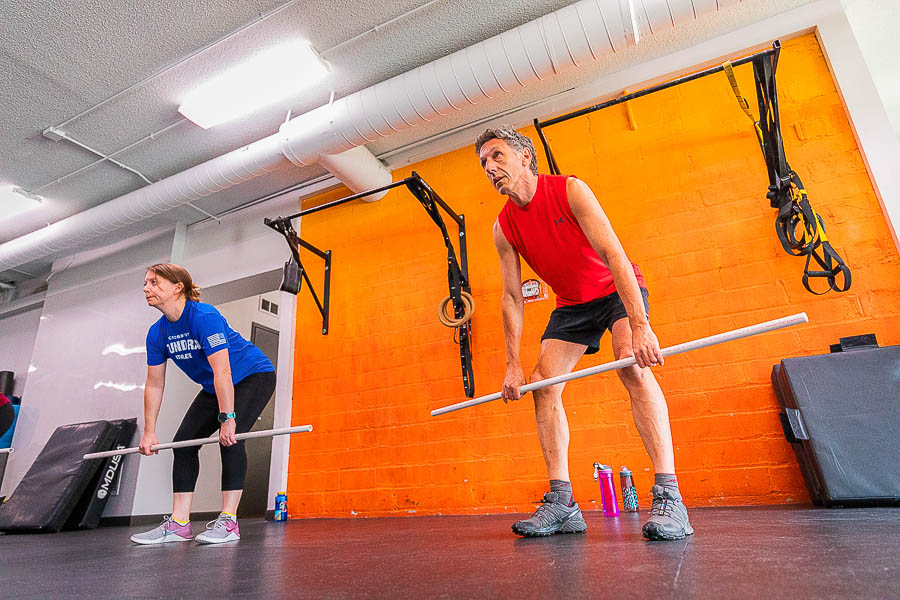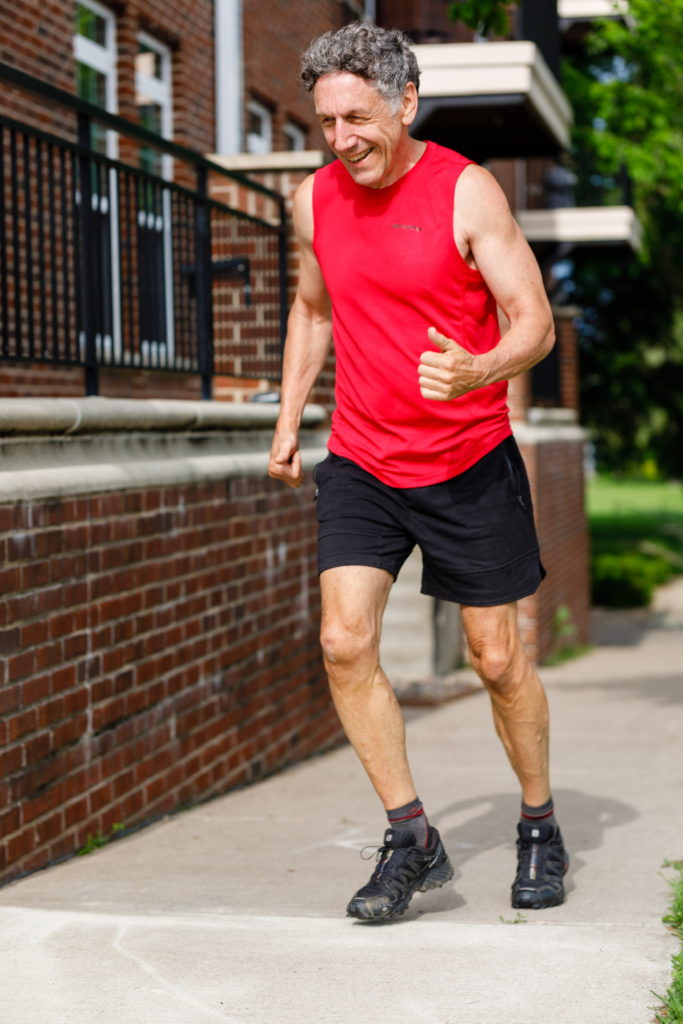
Bruce Jacobs before and after two years of CrossFit training
When Bruce Jacobs started CrossFit at age 64, he expected to get stronger. He never imagined he’d end up standing straighter, too.
“I had not expected the profound improvement in my posture that results from doing regular workouts that require it,” the now-66-year-old said.
When was the last time you thought about your posture? In this digital age, most people spend most of their days crooked: shoulders hunched over keyboards, heads drooping toward smartphones.
If you’re young and fit, correcting such poor posture is probably not top of mind. But just as every 20-year-old will someday have to start warming up before tearing through Fran, all those fortunate enough to reach old age will have to contend with it — and posture matters.
As we age, we become more prone to osteoporosis, osteopenia, and sarcopenia. This loss of muscle strength and bone density can lead to trouble balancing at best and kyphosis — an excessive curvature of the spine — at worst. From there, you’re just one step away from a bad fall, the leading cause of death among people 65 and older in the U.S.

Jacobs sees it unfolding before his eyes every time he runs into a former high-school classmate.
“They’re getting very hunched over,” he said. “And I know how devastating that can be, and so that’s a good reminder — I don’t want that to happen.”
It’s a good thing Jacobs does CrossFit.
For years, he’d walked past Side Door CrossFit, part of The Power House in St. Paul, Minnesota, on his way to a favorite restaurant. Though he was an avid biker, swimmer, and cross-country skier, a peek through the window at the stacks of weights was enough to convince him he couldn’t do CrossFit.
But one day, he glimpsed a woman near his age lifting a small kettlebell in lieu of heavy barbells. He signed up for an introductory package, “and there was a Workout of the Day, and I thought I’d try that,” he recalled. “And I didn’t know that that was CrossFit.”
Around that time, Jacobs had a consultation with an orthopedic surgeon for his shoulder-impingement syndrome, a condition in which the edge of the shoulder blade scrapes against the rotator cuff. He could no longer bike, swim, or ski without profound pain. The surgeon told Jacobs to see a physical therapist.

“But meanwhile, in (CrossFit) class, the coach told us how to get our shoulders back for a deadlift,” Jacobs said. “And I got my shoulders very easily into a better posture, and by the time I got to the physical therapist, that shoulder pain was going away.”
But that wasn’t the only unexpected side effect of CrossFit.
Decades of desk work as an engineering manager for public television had left Jacobs slightly more hunched than he used to be — a fact his wife, a lifelong ballet dancer, often noted.
“You aren’t really standing up straight,” she would tell him.
Once Jacobs learned how to retract his scapula to set up for the deadlift, he found he could also do a front squat without tipping over. After two years of CrossFit training, he took 208th worldwide in the Men’s 65+ division of the 2021 Open — and he now stands straight enough to make anyone’s grandmother proud.
“Every time I stand up, I feel different,” he said. “I feel like I’m standing up straight just kind of naturally.”

Even his walking form, Jacobs said, has improved. He recalled a coach’s cue to keep his weight in his heels while deadlifting.
“It just dawned on me that if I use what I’ve learned in deadlifts and stay on my heels going up the hill, I can maintain proper posture,” he said. “Every time I stand up, every time I lift something, every time I walk, I’m just more aware of it.”
Jacobs retired in October 2020, and as such, gets occasional Medicare mailings. He described a pamphlet offering balance exercises such as lifting one foot off the ground while gripping a sturdy object.
“For a lot of people my age, that’s a challenge,”Jacobs said.
But thanks to CrossFit, he’s prepared for a great deal more than that.
“My fitness has gone through the roof, and I feel set for the rest of my life,” he said. “What I’m doing is going to be preventative for the rest of my life.”
Photos courtesy of Bruce Jacobs and Nick Lents Photography
Comments on Stand Tall: How Posture and Balance Can Extend and Improve Your Life
This is sooo awesome! This is why we CrossFit! Well done.
Excellent reminder. As I approach 59 with iffy posture, I and many others need this. Wish I’d listened to my mom to “stand up straight “ while young!
It's worth adding that I tried 22 years ago on my own to figure out how to stand up straight, and instead severely locked up my lower back. Multiple chiro and PT sessions didn't help. After a deep tissue massage released the spasm, I left well enough alone for 20 years until getting the solid coaching at the PowerHouse that set me straight.
Stand Tall: How Posture and Balance Can Extend and Improve Your Life
3